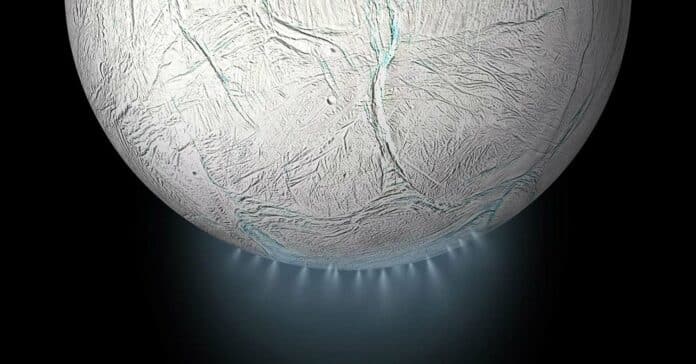Scientists are trying hard to find signs of life in space, especially in our solar system. Two moons, Enceladus and Europa, which orbit Saturn and Jupiter, seem like good places to look. They have three things that make them attractive for life: water, energy, and organic chemicals.
What’s remarkable is that these moons shoot out stuff from their underwater oceans, like a water spray. Scientists can use this spray to learn about what’s in the oceans and if they can support life. They might even send something to fly through this spray and collect samples to study. It’s like an extensive exploration to see if these moons could be home to living things.
During its 20-year mission, NASA’s Cassini spacecraft made interesting discoveries about Enceladus, one of Saturn’s moons. It found out that there were fast-moving jets of ice shooting out from Enceladus at about 800 miles per hour. These jets are an excellent chance for scientists to collect samples and learn about what’s in Enceladus’ oceans and if they could support life.
A big question was whether the high speed of these ice jets could break apart any organic compounds (like amino acids) in the samples, making them less useful for study. Well, scientists from the University of California San Diego have shown in their labs that amino acids, essential for life, can survive these high-impact speeds of up to 4.2 km/s. This is good news because it supports the idea that we can detect these essential building blocks of life when spacecraft collect samples from Enceladus.
Scientists used a custom-built aerosol impact spectrometer to study the collision dynamics of single aerosols and particles at high velocities. The device can select single particles and accelerate or decelerate them to chosen final velocities.
UC San Diego Distinguished Professor of Chemistry and Biochemistry Robert Continetti said, “From several micron diameters down to hundreds of nanometers, in a variety of materials, we’re able to examine particle behavior, such as how they scatter or how their structures change upon impact.”
In a groundbreaking experiment, scientists created ice grains in a lab using electrospray ionization. This method involves pushing water through a needle with high voltage, breaking it into tiny droplets. These droplets are then frozen in a vacuum.
Scientists measured the mass and charge of these ice grains and observed them using image charge detectors as they passed through a spectrometer. This experiment is unique because the team installed a microchannel plate ion detector to precisely measure the moment of impact when a single ice grain hits a surface, down to the nanosecond.
This experiment moves us closer to finding signs of life on far-off ocean worlds without sending a mission to their surfaces by illuminating how molecules in ice grains might withstand impact when retrieved by a probe.
The findings from the experiment revealed that amino acids, which are crucial components often referred to as the building blocks of life, can be identified with minimal breakage or fragmentation even at impact velocities as high as 4.2 km/s.
UC San Diego Distinguished Professor of Chemistry and Biochemistry Robert Continetti said, “To get an idea of what kind of life may be possible in the solar system, you want to know there hasn’t been a lot of molecular fragmentation in the sampled ice grains, so you can get that fingerprint of whatever it is that makes it a self-contained life form. Our work shows that this is possible with the ice plumes of Enceladus.”
Continetti’s research contributes to our understanding of potential life detection on icy moons and brings up intriguing questions about chemistry. One such question is how salt influences the detectability of specific amino acids. Enceladus is thought to have extensive salty oceans, even more than what we have on Earth.
Since salt can alter the characteristics of water as a solvent and impact the solubility of various molecules, specific molecules may gather on the surface of ice grains, potentially making them easier to detect. This aspect of the research highlights the complex interactions between the unique conditions on these distant moons and the detectability of critical molecules for life.
Continetti said, “The implications this has for detecting life elsewhere in the solar system without missions to the surface of these ocean-world moons is very exciting, but our work goes beyond biosignatures in ice grains.”
“It has implications for fundamental chemistry as well. We are excited by the prospect of following in the footsteps of Harold Urey and Stanley Miller, founding faculty at UC San Diego, in looking at the formation of the building blocks of life from chemical reactions activated by ice grain impact.”
Journal Reference:
- Sally E. Burke et al., Detection of intact amino acids with a hypervelocity ice grain impact mass spectrometer, Proceedings of the National Academy of Sciences (2023). DOI: 10.1073/pnas.2313447120
